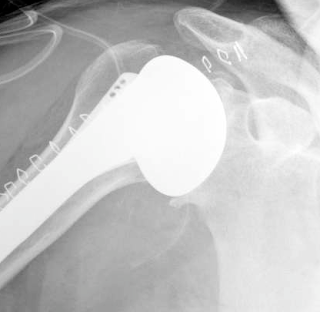The image above is the AP X-ray of a patient from our surgical schedule this week with osteoarthritis (degenerative joint disease) of the shoulder. Note the loss of the normal joint space, the flattened joint surface and the bone spurs above and below the joint.
The image above is the Axillary X-ray of our patient with osteoarthritis (degenerative joint disease) of the shoulder. Note the loss of the normal joint space and the displacement of the ball towards the back of the socket (downward on this image) so that the 'golf ball' is not sitting centered in the 'tee'.
The image above is the AP view of this shoulder in the recovery room after a ream and run procedure. Note the ball of the humeral prosthesis sits centered in the contoured glenoid bone. The staples for wound closure and the drain are seen at upper left.
The image above is the Axillary view of this shoulder in the recovery room after a ream and run procedure. Note the ball of the humeral prosthesis sits centered in the contoured glenoid bone. The 'golf ball' is back in the 'tee'.
Cartilage cannot be seen on X-rays, but the thickness of cartilage can be detected by observing the separation of the bones, the 'radiographic joint space'.
Let's take a look at how the shoulder should be x-rayed to diagnose shoulder arthritis and to plan a joint replacement.
In the shoulder, two X-ray views are essential for determining the 'joint space', the AP (anteroposterior) and the axillary views.
An AP view of a normal shoulder looks like this:
and an axillary view of a normal shoulder looks like this:
In each view one can see the separation of the ball from the socket due to the presence of cartilage in this normal right shoulder.
These views must be taken carefully to make sure that poor technique does not hide the true condition of the joint.
More about x-rays in arthritis can be found at this link.
To add this blog to your reading list in Google Chrome, click on the reading list icon
You can support cutting edge shoulder research that is leading to better care for patients with shoulder problems, click on this link.
Follow on twitter: https://twitter.com/shoulderarth
Follow on facebook: click on this link
Follow on facebook: https://www.facebook.com/frederick.matsen
Follow on LinkedIn: https://www.linkedin.com/in/rick-matsen-88b1a8133/
Here are some videos that are of shoulder interestShoulder arthritis - what you need to know (see this link).How to x-ray the shoulder (see this link).The ream and run procedure (see this link).The total shoulder arthroplasty (see this link).The cuff tear arthropathy arthroplasty (see this link).The reverse total shoulder arthroplasty (see this link).The smooth and move procedure for irreparable rotator cuff tears (see this link).
Follow on twitter: https://twitter.com/shoulderarth
Follow on facebook: click on this link
Follow on facebook: https://www.facebook.com/frederick.matsen
Follow on LinkedIn: https://www.linkedin.com/in/rick-matsen-88b1a8133/
Here are some videos that are of shoulder interest
Shoulder arthritis - what you need to know (see this link).
How to x-ray the shoulder (see this link).
The ream and run procedure (see this link).
The total shoulder arthroplasty (see this link).
The cuff tear arthropathy arthroplasty (see this link).
The reverse total shoulder arthroplasty (see this link).
The smooth and move procedure for irreparable rotator cuff tears (see this link).
Shoulder rehabilitation exercises (see this link).








